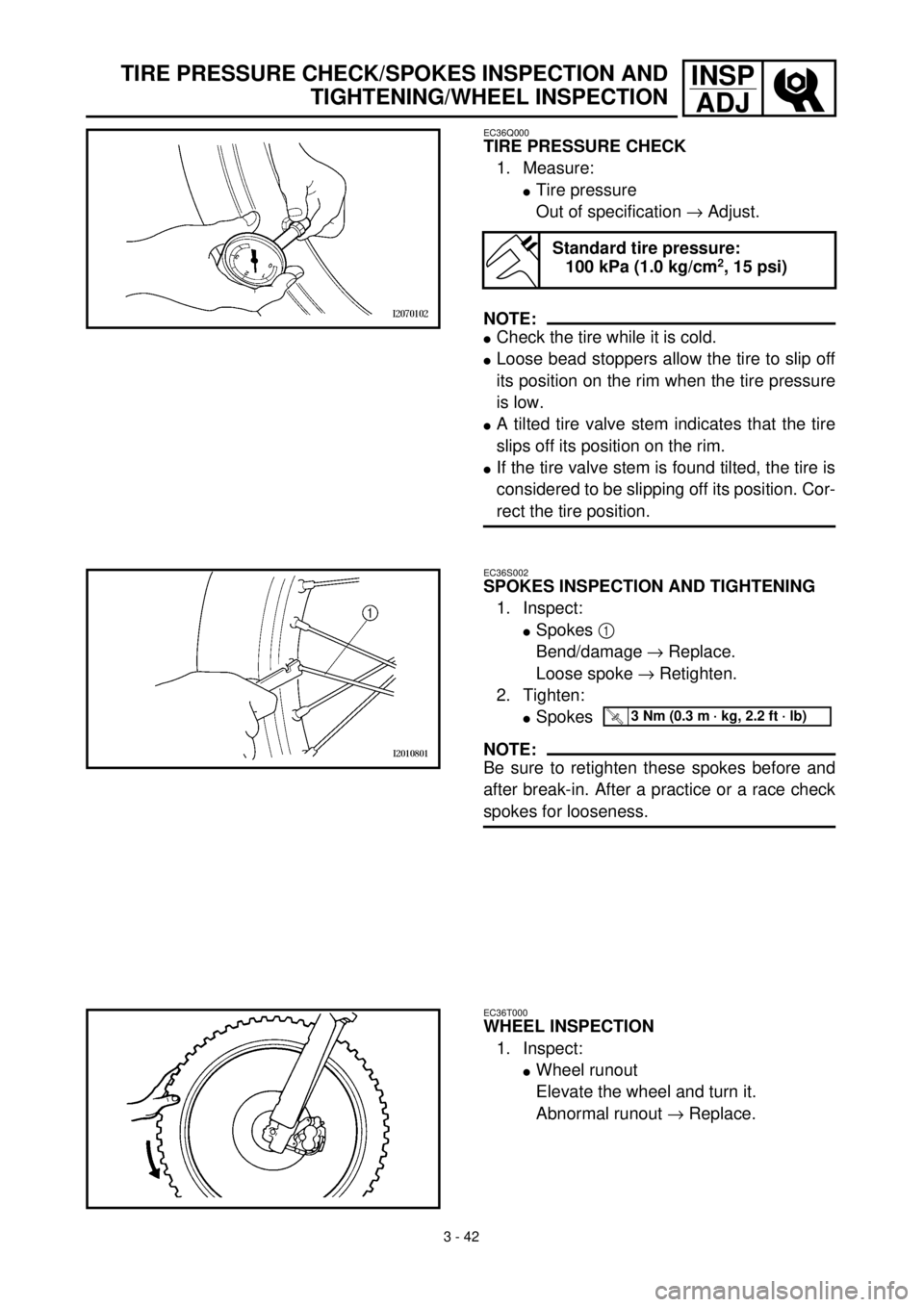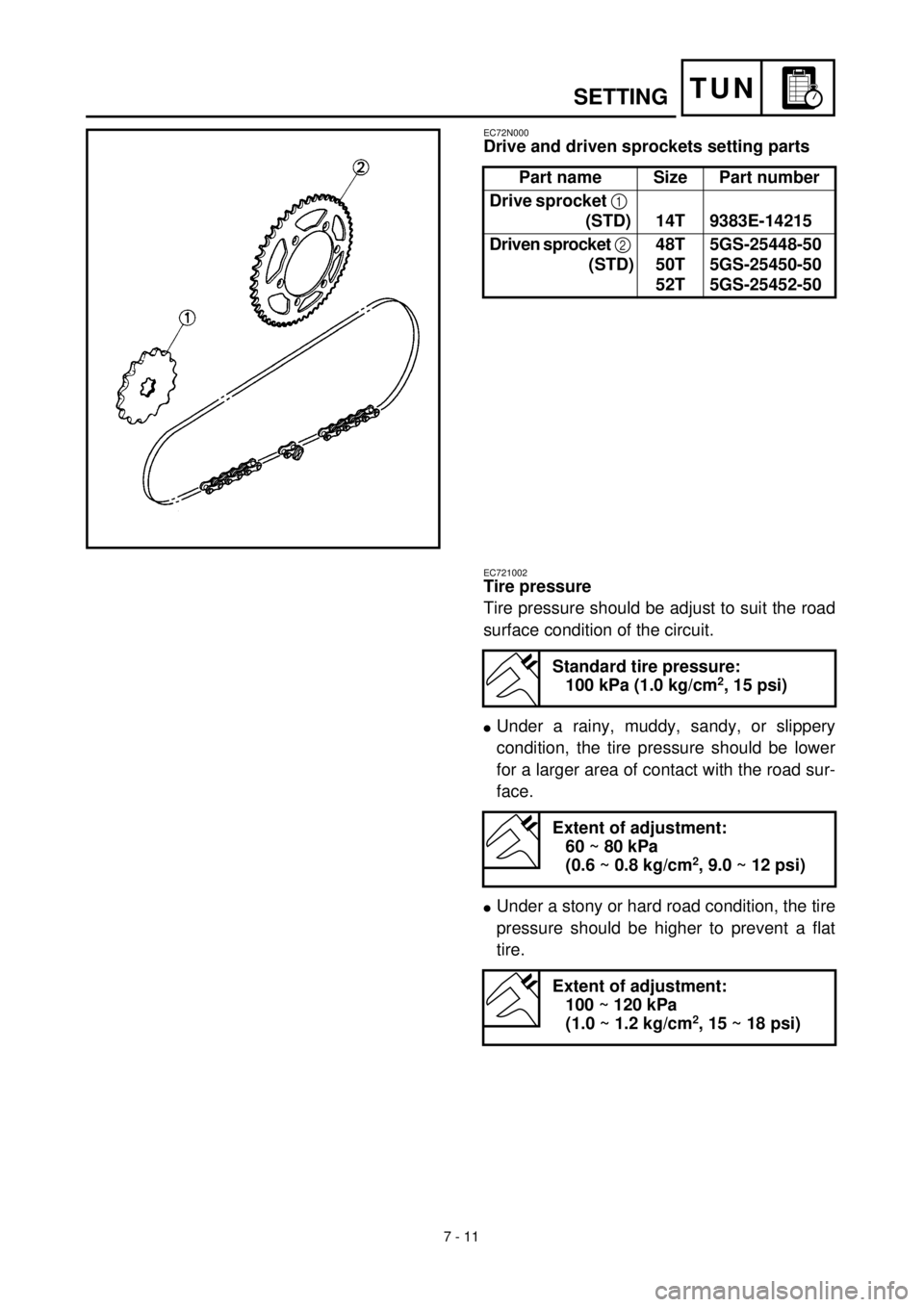tire pressure YAMAHA WR 400F 2000 Owners Manual
[x] Cancel search | Manufacturer: YAMAHA, Model Year: 2000, Model line: WR 400F, Model: YAMAHA WR 400F 2000Pages: 654, PDF Size: 60.12 MB
Page 74 of 654

2 - 3
SPEC
GENERAL SPECIFICATIONS
Tire:
Type With tube
Size (front) 80/100-21 51M (USA, CDN, ZA)
90/90-21 54R (EUROPE, AUS, NZ)
Size (rear) 110/100-18 64M (USA, CDN, ZA)
120/90-18 65R (EUROPE, AUS, NZ)
Tire pressure (front and rear) 100 kPa (1.0 kg/cm
2
, 15 psi)
Brake:
Front brake type Single disc brake
Operation Right hand operation
Rear brake type Single disc brake
Operation Right foot operation
Suspension:
Front suspension Telescopic fork
Rear suspension Swingarm (link type monocross suspension)
Shock absorber:
Front shock absorber Coil spring/oil damper
Rear shock absorber Coil spring/gas, oil damper
Wheel travel:
Front wheel travel 300 mm (11.8 in)
Rear wheel travel 315 mm (12.4 in)
Electrical:
Ignition system CDI magneto
Page 158 of 654

3 - 3
INSP
ADJ
MAINTENANCE INTERVALS
FRONT FORK OIL SEAL AND DUST
SEAL
Clean and lube
cc
Lithium base grease
REAR SHOCK ABSORBER
Inspect and adjust
Lube and retighten
c
cc
c
Lithium base grease
CHAIN GUARD AND ROLLERS
Inspect
cc
SWINGARM
Inspect and retighten
cc
RELAY ARM, CONNECTING ROD
Inspect and lube
cc
Lithium base grease
STEERING HEAD
Inspect free play and retighten
Clean and lube
Replace bearing
cc
c
c
Lithium base grease
TIRE, WHEELS
Inspect air pressure, wheel run-out,
tire wear and spoke looseness
Retighten sprocket bolt
Inspect bearings
Replace bearings
Lubricate
c
cc
c
c
cc
Lithium base grease
THROTTLE, CONTROL CABLE
Check routing and connection
Lubricate
c
cc
c
Yamaha cable lube or
SAE 10W-30 motor oil ItemAfter
break-inEvery
race
Every
third
(or
500 km)Every
fifth
(or
1,000 km)
As re-
quiredRemarks
Page 168 of 654

3 - 4
INSP
ADJ
PRE-OPERATION INSPECTION AND MAINTENANCE
EC320000
PRE-OPERATION INSPECTION AND MAINTENANCE
Before riding for break-in operation, practice or a race, make sure the machine is in good operating
condition.
Before using this machine, check the following points.
GENERAL INSPECTION AND MAINTENANCE
Item Routine Page
CoolantCheck that coolant is filled up to the radiator filler cap.
Check that the coolant level is correct in the coolant reservoir
tank.
Check the cooling system for leakage.P.3-5 ~ 9
FuelCheck that a fresh gasoline is filled in the fuel tank. Check the
fuel line for leakage.P.1-12
Engine oilCheck that the oil level is correct. Check the crankcase and
frame oil line for leakage.P.3-13 ~ 17
Gear shifter and clutchCheck that gears can be shifted correctly in order and that the
clutch operates smoothly.P.3-9
Throttle grip/HousingCheck that the throttle grip operation and free play are correctly
adjusted. Lubricate the throttle grip and housing, if necessary.P.3-10 ~ 11
Brakes Check the play of front brake and effect of front and rear brake. P.3-25 ~ 31
ChainCheck chain slack and alignment. Check that the chain is lubri-
cated properly.P.3-32 ~ 34
WheelsCheck for excessive wear and tire pressure. Check for loose
spokes and have no excessive play.P.3-42 ~ 43
SteeringCheck that the handlebar can be turned smoothly and have no
excessive play.P.3-43 ~ 44
Front forks and rear shock
absorberCheck that they operate smoothly and there is no oil leakage. P.3-34 ~ 41
Cables (wires)Check that the clutch and throttle cables move smoothly. Check
that they are not caught when the handlebars are turned or
when the front forks travel up and down.—
Muffler Check that the muffler is tightly mounted and has no cracks. P.4-2
Sprocket Check that the driven sprocket tightening bolt is not loose. P.3-32
Lubrication Check for smooth operation. Lubricate if necessary. P.3-45
Bolts and nuts Check the chassis and engine for loose bolts and nuts. P.1-17
Lead connectorsCheck that the CDI magneto, CDI unit, and ignition coil are con-
nected tightly.P.1-5
SettingsIs the machine set suitably for the condition of the racing course
and weather or by taking into account the results of test runs
before racing? Are inspection and maintenance completely
done?P.7-1 ~ 21
Page 248 of 654

3 - 42
INSP
ADJTIRE PRESSURE CHECK/SPOKES INSPECTION AND
TIGHTENING/WHEEL INSPECTION
EC36Q000
TIRE PRESSURE CHECK
1. Measure:
lTire pressure
Out of specification ® Adjust.
NOTE:
lCheck the tire while it is cold.
lLoose bead stoppers allow the tire to slip off
its position on the rim when the tire pressure
is low.
lA tilted tire valve stem indicates that the tire
slips off its position on the rim.
lIf the tire valve stem is found tilted, the tire is
considered to be slipping off its position. Cor-
rect the tire position.
Standard tire pressure:
100 kPa (1.0 kg/cm2, 15 psi)
EC36S002
SPOKES INSPECTION AND TIGHTENING
1. Inspect:
lSpokes 1
Bend/damage ® Replace.
Loose spoke ® Retighten.
2. Tighten:
lSpokes
NOTE:
Be sure to retighten these spokes before and
after break-in. After a practice or a race check
spokes for looseness.
T R..3 Nm (0.3 m · kg, 2.2 ft · lb)
EC36T000
WHEEL INSPECTION
1. Inspect:
lWheel runout
Elevate the wheel and turn it.
Abnormal runout ® Replace.
Page 628 of 654

7 - 11
TUN
EC72N000
Drive and driven sprockets setting parts
Part name Size Part number
Drive sprocket 1
(STD) 14T 9383E-14215
Driven sprocket 2
(STD)48T
50T
52T5GS-25448-50
5GS-25450-50
5GS-25452-50
EC721002
Tire pressure
Tire pressure should be adjust to suit the road
surface condition of the circuit.
lUnder a rainy, muddy, sandy, or slippery
condition, the tire pressure should be lower
for a larger area of contact with the road sur-
face.
lUnder a stony or hard road condition, the tire
pressure should be higher to prevent a flat
tire.
Standard tire pressure:
100 kPa (1.0 kg/cm2, 15 psi)
Extent of adjustment:
60 ~ 80 kPa
(0.6 ~ 0.8 kg/cm
2, 9.0 ~ 12 psi)
Extent of adjustment:
100 ~ 120 kPa
(1.0 ~ 1.2 kg/cm
2, 15 ~ 18 psi)
SETTING